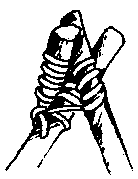List of knot terminology
This page explains commonly used terms related to knots.
B
Bend
A bend is a knot used to join two lengths of rope.
Bight

A bight has two meanings in knotting. It can mean either any central part of a rope (between the standing end and the working end) or an arc in a rope that is at least as wide as a semicircle.[1] In either case, a bight is a length of rope that does not cross itself.[2] Knots that can be tied without use of the working end are called knots on the bight.
Binding knot
Binding knots are knots that either constrict a single object or hold two objects snugly together. Whippings, seizings and lashings serve a similar purpose to binding knots, but contain too many wraps to be properly called a knot.[1] In binding knots, the ends of rope are either joined together or tucked under the turns of the knot.
Bitter end
Another term for the working end.
C
Capsizing
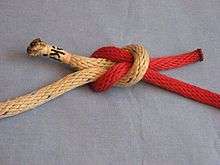
A knot that has capsized has deformed into a different structure. Although capsizing is sometimes the result of incorrect tying or misuse, it can also be done purposefully in certain cases to strengthen the knot (see the carrick bend).[3]
Chirality
Chirality is the 'handedness' of a knot. Topologically speaking, a knot and its mirror image may or may not have knot equivalence.[4]
D
Decorative knot
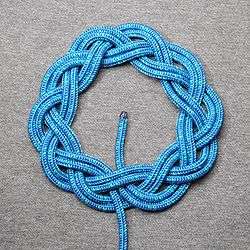
A decorative knot is any aesthetically pleasing knot. Although it is not necessarily the case, most decorative knots also have practical applications or were derived from other well-known knots.[5] Decorative knotting is one of the oldest and most widely distributed folk art.[5]
Dressing
Knot dressing is the process of arranging a knot in such a way as to improve its performance. Crossing or uncrossing the rope in a specific way, depending on the knot, can increase the knot's strength as well as reduce its jamming potential.[6]
E
Elbow
An elbow refers to any two nearby crossings of a rope. An elbow is created when an additional twist is made in a loop.[7]
F
Flake
A flake refers to any number of turns in a coiled rope. Likewise, to flake a rope means to coil it.[1]
"Flaking" or "Faking" also means to lay a rope on a surface ready to use or to run out quickly without tangles [8]
Fraps
Fraps are a set of loops coiled perpendicularly around the wraps of a lashing as a means of tightening.[9]
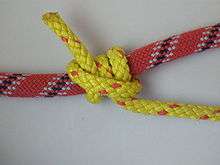
Friction hitch
A friction hitch is a knot that attaches one rope to another in a way that allows the knot's position to easily be adjusted. Sometimes friction hitches are called slide-and-grip knots.[10] They are often used in climbing applications.
H
Hitch
A hitch is a knot that attaches a rope to some object, often a ring, rail, spar, or post.[11]
J
Jamming
A jamming knot is any knot that becomes very difficult to untie after use.[12] Knots that are resistant to jamming are called non-jamming knots.
L
Lashing
A lashing is an arrangement of rope used to secure two or more items together in a rigid manner. Common uses include the joining scaffolding poles and the securing of sailing masts.[13][14] The square lashing, diagonal lashing, and shear lashing are well-known lashings used to bind poles perpendicularly, diagonally, and in parallel, respectively.[15]
Loop

In reference to knots, loop may refer to:
- One of the fundamental structures used to tie knots. Specifically, it is a U-form narrower than a bight.[16]
- A type of knot used to create a closed circle in a line.
A loop is one of the fundamental structures used to tie knots. It is a full circle formed by passing the working end of a rope over itself. When the legs of a closed loop are crossed to form a loop, the rope has taken a turn.[1]
Loop knot
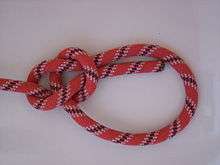
A loop knot is the type of knot that forms a fixed loop. It is created either when the end of a rope is fastened to its own standing part or when a loop in the bight of a rope is knotted. Unlike a hitch, a loop knot creates a fixed loop in a rope that maintains its structure regardless of whether or not it is fastened to an object. In other words, a loop knot can be removed from an object without losing its shape.[1]
N
Noose
A noose can refer to any sliding loop in which the loop tightens when pulled.[3]
O
Open loop
An open loop is a curve in a rope that resembles a semicircle in which the legs are not touching or crossed. The legs of an open loop are brought together narrower than they are in a bight.[1]
S

Seizing
A seizing is a knot that binds two pieces of rope together side by side, normally in order to create a loop. The structure of seizings is similar to that of lashings.[17]
Setting
Setting a knot is the process of tightening it. Improper setting can cause certain knots to underperform.[6]
Slipped knot
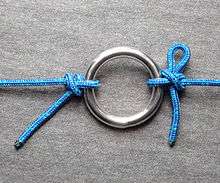
A slipped knot is any knot that unties when an end is pulled. Thus, tying the slipped form of a knot makes it easier to untie, especially when the knot is prone to jamming.[1]
Small-stuff
Small-stuff is a nautical and knot-tying term for thin string or twine, as opposed to the thick, heavy ropes that are more often used in sailing. It is commonly used in a whipping to bind the ends of ropes to prevent fraying.
Historically, the term referred to cordage less than one inch in circumference.[18] Much of the small-stuff onboard ships, especially that used for decorative or fancy ropework, was made by the sailors themselves reusing materials unlaid from old and leftover pieces of larger rope and cable.[19]
Splice
Splicing is a method of joining two ropes done by untwisting and then re-weaving the rope's strands.[20]
Standing end
The standing end (or standing part) of a rope is the part not active in knot tying.[1] It is the part opposite of the working end.[3]
Stopper knot
A stopper knot is the type of knot tied to prevent a rope slipping through a grommet.[21] The overhand knot is the simplest single-strand stopper knot.[1]
T
Turn
A turn is one round of rope on a pin or cleat, or one round of a coil.
W
Whipping
A whipping is a binding knot tied around the end of a rope to prevent the rope from unraveling.[17]
Working end
The working end (or working part) of a rope is the part active in knot tying.[1] It is the part opposite of the standing end.[3]
See also
References
- 1 2 3 4 5 6 7 8 9 10 Clifford W., Ashley. The Ashley Book of Knots. Doubleday, New York. pp. 11–20, 219, 597–599. ISBN 0-385-04025-3.
- ↑ "Rope and Knot Terminology". Upper Ojai Search and Rescue Team. Ventura Country Sheriff's Department. Retrieved 19 July 2011.
- 1 2 3 4 Budworth, Geoffrey (July 1, 1997). The Complete Book of Knots (1 ed.). The Lyons Press. pp. 156–157. ISBN 1-55821-632-4.
- ↑ "Basic Knot Theory Terminology" (PDF). Stanford ESP. Retrieved 19 July 2011.
- 1 2 3 Owen, Peter (1994). The Book of Decorative Knots. Guilford, Connecticut: The Lyons Press. ISBN 1-55821-304-X.
- 1 2 Kidd, Timothy W.; Jennifer Hazelrigs (2009). Rock Climbing. Champaign, Illinois: Human Kinetics. pp. 126–127. ISBN 0-7360-6802-3.
- ↑ Costantino, Maria (March 1, 2007). The Knot Handbook. Sterling. pp. 252–254. ISBN 1-4027-4804-3.
- ↑ http://www.animatedknots.com/fig8flake/index.php
- ↑ "U.S. Army Field Manual FM 3-05.70 - Ropes and Knots". Headquarters, Department of the Army. May 2002. Retrieved 23 July 2011.
- ↑ Adams, Mark (April 2005). "A Genealogy of Arborists' Climbing Hitches" (PDF). Arborist News.
- ↑ Budworth, Geoffrey (September 1, 2002). The Illustrated Encyclopedia of Knots. Lyons Press. p. 157. ISBN 1-58574-626-6.
- ↑ Partridge, William E. (1908). "The Knots in Common Use". Yachting. 3: 97.
- ↑ Hasluck, Paul N., ed. (October 15, 2009). Knotting And Splicing Ropes And Cordage. Kessinger Publishing, LLC. p. 130. ISBN 1-120-30885-2.
- ↑ Biddlecombe, George (1990). The Art of Rigging (1 ed.). Mineola, New York. p. 19. ISBN 0-486-26343-6.
- ↑ Macfarlan, Allan and Paulette (September 1, 1983). Knotcraft: The Practical and Entertaining Art of Tying Knots. Dover Publications. ISBN 0-486-24515-2.
- ↑ Clifford W. Ashley, The Ashley Book of Knots. Image 31, 32.
- 1 2 Merry, Barbara; Martin Dugard (February 16, 2000). The Splicing Handbook: Techniques for Modern and Traditional Ropes (2 ed.). International Marine/Ragged Mountain Press. p. 113. ISBN 978-0-07-135438-7.
- ↑ Clifford W. Ashley, The Ashley Book of Knots (New York: Doubleday, 1944), 603.
- ↑ Ashley, 549.
- ↑ Smith, Hervey G. (September 1, 1990). The Arts of the Sailor: Knotting, Splicing and Ropework. Dover Publications. p. 2. ISBN 0-486-26440-8.
- ↑ Wing, Charlie (May 2007). How Boat Things Work: An Illustrated Guide. McGraw-Hill. p. 97. ISBN 0-07-149344-1.
